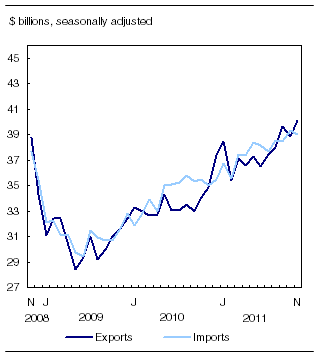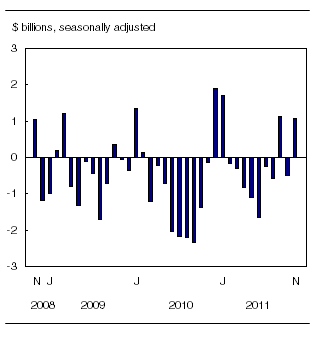Canadian international merchandise trade
Archived Content
Information identified as archived is provided for reference, research or recordkeeping purposes. It is not subject to the Government of Canada Web Standards and has not been altered or updated since it was archived. Please "contact us" to request a format other than those available.
Related subjects
-
[an error occurred while processing this directive]
Canada's merchandise exports increased 3.2%, while imports declined 0.8%. As a result, Canada's trade balance with the world went from a deficit of $487 million in October to a surplus of $1.1 billion in November.
Exports and imports

Chart description: Exports and imports
Exports rose to $40.1 billion, as most sectors posted gains. Prices increased 1.7%, led by energy products, while volumes rose 1.6%, largely the result of automotive products.
Imports declined to $39.0 billion, as both volumes and prices fell. The overall decline in imports was attributable to lower imports of automotive products, as well as industrial goods and materials. The decline was partially offset by an increase in energy products.
Canada's trade surplus with the United States increased from $3.5 billion in October to $4.6 billion in November. Exports to the United States rose 1.9% to $28.6 billion, on the strength of energy products. Imports from the United States declined 2.0% to $24.0 billion, largely the result of lower imports of automotive products.
Exports to countries other than the United States rose 6.7% to $11.5 billion, mainly the result of higher exports to the European Union. Imports from countries other than the United States increased 1.3% to $15.0 billion, the fourth consecutive monthly gain. Canada's trade deficit with countries other than the United States narrowed from $4.0 billion in October to $3.5 billion in November.
Note to readers
Merchandise trade is one component of Canada's international balance of payments (BOP), which also includes trade in services, investment income, current transfers as well as capital and financial flows.
International merchandise trade data by country are available on both a BOP and a customs basis for the United States, Japan and the United Kingdom. Trade data for all other individual countries are available on a customs basis only. BOP data are derived from customs data by making adjustments for factors such as valuation, coverage, timing and residency. These adjustments are made to conform to the concepts and definitions of the Canadian System of National Accounts.
Data in this release are on a BOP basis, seasonally adjusted and in current dollars. Constant dollars are calculated using the Laspeyres volume formula.
Changes to the classification
Statistics Canada has reduced the number of 10-digit Harmonized Commodity Coding and Description System (HS) classification codes that are used to report the commodity detail in Canada's merchandise import trade data. This will improve efficiency, maintain data quality and reduce response burden.
These changes are in effect as of January 2012 and coincide with the World Customs Organization 2012 amendments to the 6-digit HS classification codes as well as with Finance Canada's changes to the 2012 Customs Tariff at the 8-digit HS codes. To obtain an HS 2012 Concordance Table, contact the International Trade Division's Marketing and Client Services Section (trade@statcan.gc.ca).
Energy products lead the increase in exports
Exports of energy products increased 6.4% to $10.0 billion in November, as prices increased 6.3%. Exports of crude petroleum rose for the fourth consecutive month to a record high of $6.4 billion. Strong gains were also reported in petroleum and coal products, which rose 17.6%, and coal and other bituminous substances, which were up 28.5%. Lower exports of natural gas moderated the sector's increase.
Exports of industrial goods and materials rose 4.0% to $10.2 billion in November. Higher volumes of precious metals and alloys, as well as other crude non-metallic minerals, drove the gain. The increase was partially offset by a decline in volumes of fertilizers and fertilizer materials.
Exports of automotive products increased for a third consecutive month in November, rising 4.9% to $5.3 billion. Exports of passenger autos and chassis rose 8.5% to $3.6 billion, their highest level since January 2011. The gain was the result of higher volumes.
Imports: Automotive products, and industrial goods and materials lead the decline
Imports of automotive products declined 4.4% to $5.7 billion in November, as volumes fell 4.0%. Trucks and other motor vehicles fell 13.6%, while passenger autos and chassis fell 8.1%. Partly offsetting these declines was a 3.8% increase in motor vehicle parts.
Imports of industrial goods and materials fell 3.0% to $8.3 billion following three consecutive monthly increases. Prices declined 3.7%. Imports of metals and metal ores fell 6.4%, with precious metals and alloys leading the decline.
Imports of machinery and equipment declined 1.1% to $10.7 billion in November, as decreases occurred in three of four sub-sectors. Aircraft and other transportation equipment fell 10.1%, the result of a decline in volumes. Higher imports of other machinery and equipment partially offset the overall decrease.
Imports of energy products increased 2.0% to $4.6 billion, the third consecutive monthly increase. Petroleum and coal products, namely fuel oil, rose 9.1% in November.
Trade balance

Chart description: Trade balance
Note: In general, merchandise trade data are revised on an ongoing basis for each month of the current year. Current year revisions are reflected in both the customs and balance of payments (BOP) based data. The previous year's customs data are revised with the release of the January and February reference months as well as on a quarterly basis. The previous two years of customs based data are revised annually and are released in February with the December reference month. The previous year's BOP based data are revised with the release of the January, February and March reference months. Revisions to BOP based data for the previous three years are released annually in June with the April reference month.
Factors influencing revisions include late receipt of import and export documentation, incorrect information on customs forms, replacement of estimates produced for the energy sector with actual figures, changes in classification of merchandise based on more current information, and changes to seasonal adjustment factors.
Revised data are available in the appropriate CANSIM tables.
Available on CANSIM: tables 228-0001 to 228-0003, 228-0033, 228-0034, 228-0041 to 228-0043 and 228-0047 to 228-0057.
The merchandise imports and exports data in the following tables are presented in dollar values.
Tables 228-0001 to 228-0003: Customs and balance of payments basis, by major groups and principal trading areas for all countries; monthly, quarterly and annual.
Table 228-0033: Imports, customs-based, by province of clearance; monthly.
Table 228-0034: Domestic exports, customs-based, by province of origin; monthly.
Tables 228-0041 to 228-0043: Customs and balance of payments basis, by sector and sub-sector, for all countries; monthly, quarterly and annual.
The merchandise imports and exports data in the following tables are indexes (2002=100).
Tables 228-0047 to 228-0049: Balance of payments and customs-based price and volume indexes for all countries; monthly, quarterly and annual.
Tables 228-0050 to 228-0052: Customs-based price indexes, Canada and United States trade, and Standard International Trade Classification (SITC revision 3) price indexes for all countries and United States; monthly, quarterly and annual.
Tables 228-0053 to 228-0055: Price and volume indexes, customs and balance of payments basis, by sector and sub-sector, for all countries; monthly, quarterly and annual.
Tables 228-0056 and 228-0057: Balance of payments basis, by sector, seasonally adjusted, Fisher formula, chained 2002 dollars, for all countries; monthly and quarterly.
Definitions, data sources and methods: survey numbers, including related surveys, 2201, 2202 and 2203.
These data are available in the Canadian international merchandise trade database.
The November 2011 issue of Canadian International Merchandise Trade, Vol. 65, no. 11 (65-001-X, free), is now available from the Key resource module of our website under Publications.
Current account data (which incorporate merchandise trade statistics, service transactions, investment income and transfers) are available quarterly in Canada's Balance of International Payments (67-001-X, free).
Data on Canadian International Merchandise Trade for December will be released on February 10.
For more information, contact Statistics Canada's National Contact Centre (toll-free 1-800-263-1136; 613-951-8116; infostats@statcan.gc.ca), Communications Division.
To enquire about the concepts, methods or data quality of this release, contact Marc Nadeau (613-951-3692), International Trade Division.
- Date modified:
